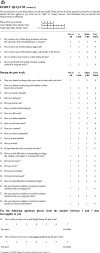Review on quality of life issues in patients with primary brain tumors
- PMID: 20507891
- PMCID: PMC3227985
- DOI: 10.1634/theoncologist.2009-0291
Review on quality of life issues in patients with primary brain tumors
Abstract
Health-related quality of life (HRQOL) has become an important outcome measure in clinical trials in primary brain tumor (i.e., glioma) patients, because they have an incurable disease. HRQOL is assessed using self-reported, validated questionnaires, addressing physical, psychological, emotional, and social issues. In addition to generic HRQOL instruments, disease-specific questionnaires have been developed, including for brain tumor patients. For the analysis and interpretation of HRQOL measurements, low compliance and missing data are methodological challenges. HRQOL in glioma patients may be negatively affected by the disease itself as well as by side effects of treatment. But treatment with surgery, radiotherapy, and chemotherapy may improve patient functioning and HRQOL, in addition to extending survival. Although HRQOL has prognostic significance in brain tumor patients, it is not superior to well-known clinical parameters, such as age and performance status. In clinical practice, assessing HRQOL may be helpful in the communication between doctor and patient and may facilitate treatment decisions.
Conflict of interest statement
The content of this article has been reviewed by independent peer reviewers to ensure that it is balanced, objective, and free from commercial bias. No financial relationships relevant to the content of this article have been disclosed by the authors or independent peer reviewers.
Figures
References
-
- Ohgaki H, Kleihues P. Population-based studies on incidence, survival rates, and genetic alterations in astrocytic and oligodendroglial gliomas. J Neuropathol Exp Neurol. 2005;64:479–489. - PubMed
-
- Efficace F, Bottomley A. Health related quality of life assessment methodology and reported outcomes in randomised controlled trials of primary brain cancer patients. Eur J Cancer. 2002;38:1824–1831. - PubMed
-
- Stupp R, Mason WP, van den Bent MJ, et al. Radiotherapy plus concomitant and adjuvant temozolomide for glioblastoma. N Engl J Med. 2005;352:987–996. - PubMed
-
- Hart MG, Grant R, Garside R, et al. Temozolomide for high grade glioma. Cochrane Database Syst Rev. 2008;(4):CD007415. - PubMed
-
- Bottomley A, Flechtner H, Efficace F, et al. Health related quality of life outcomes in cancer clinical trials. Eur J Cancer. 2005;41:1697–1709. - PubMed
Publication types
MeSH terms
LinkOut - more resources
Full Text Sources
Medical



